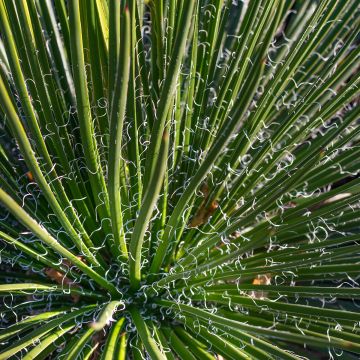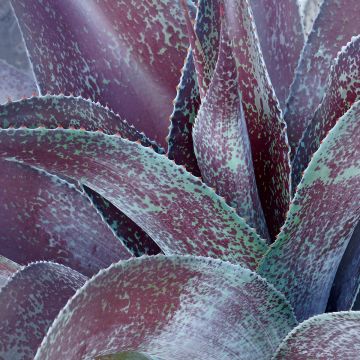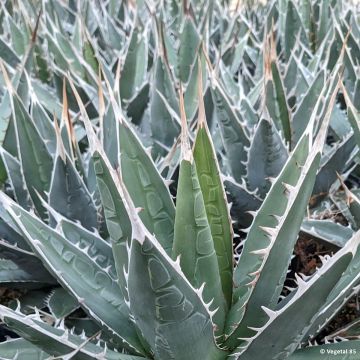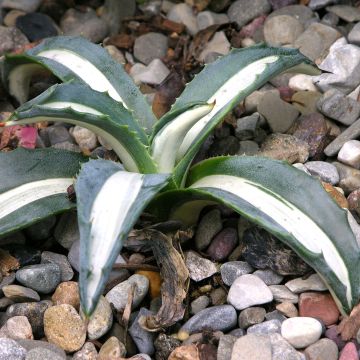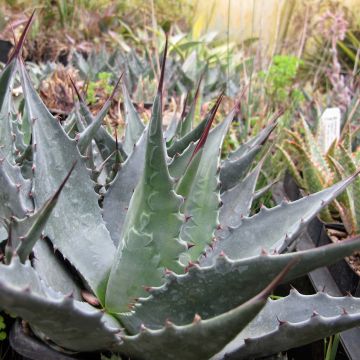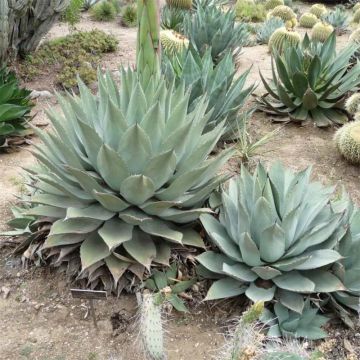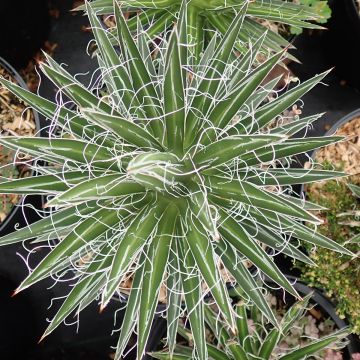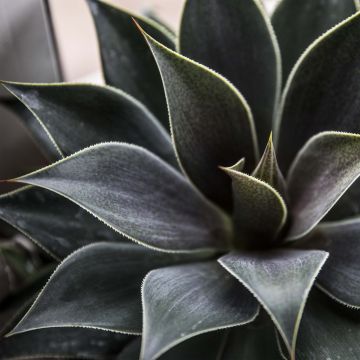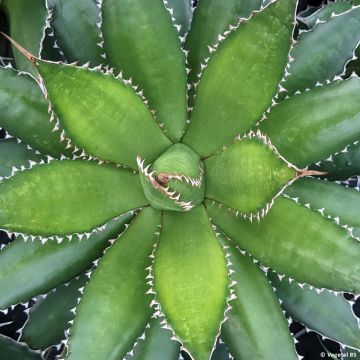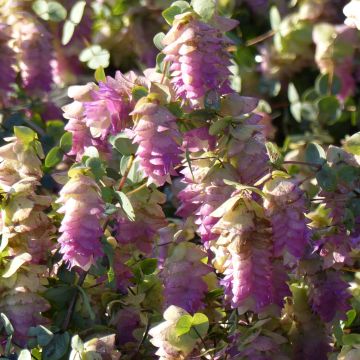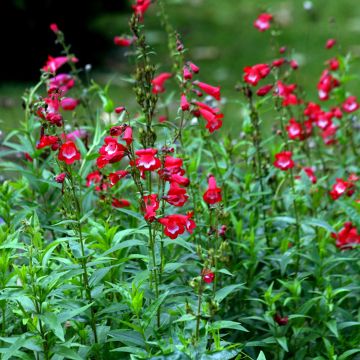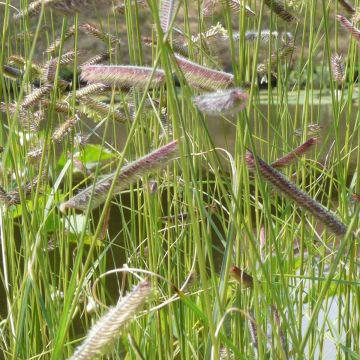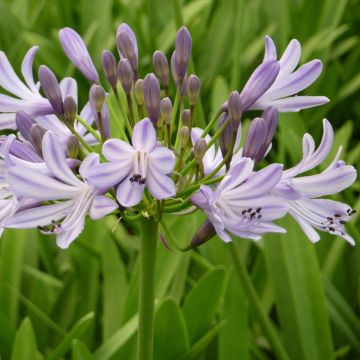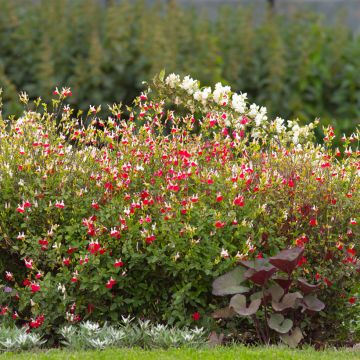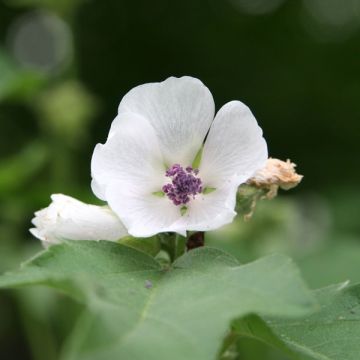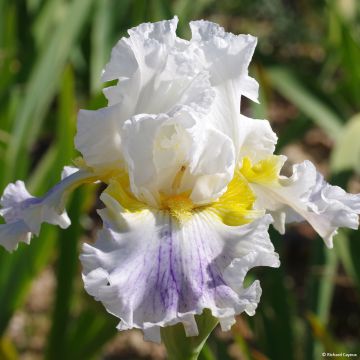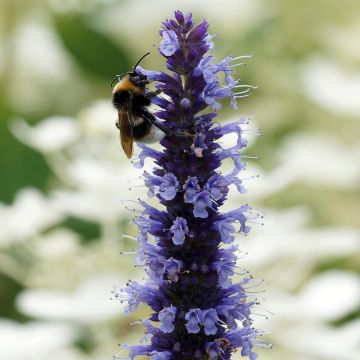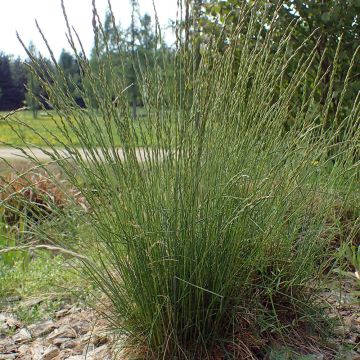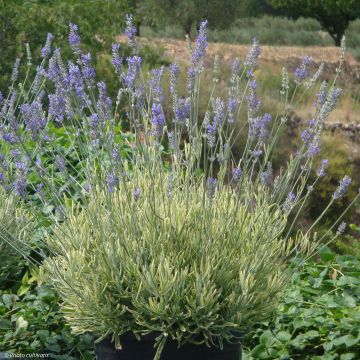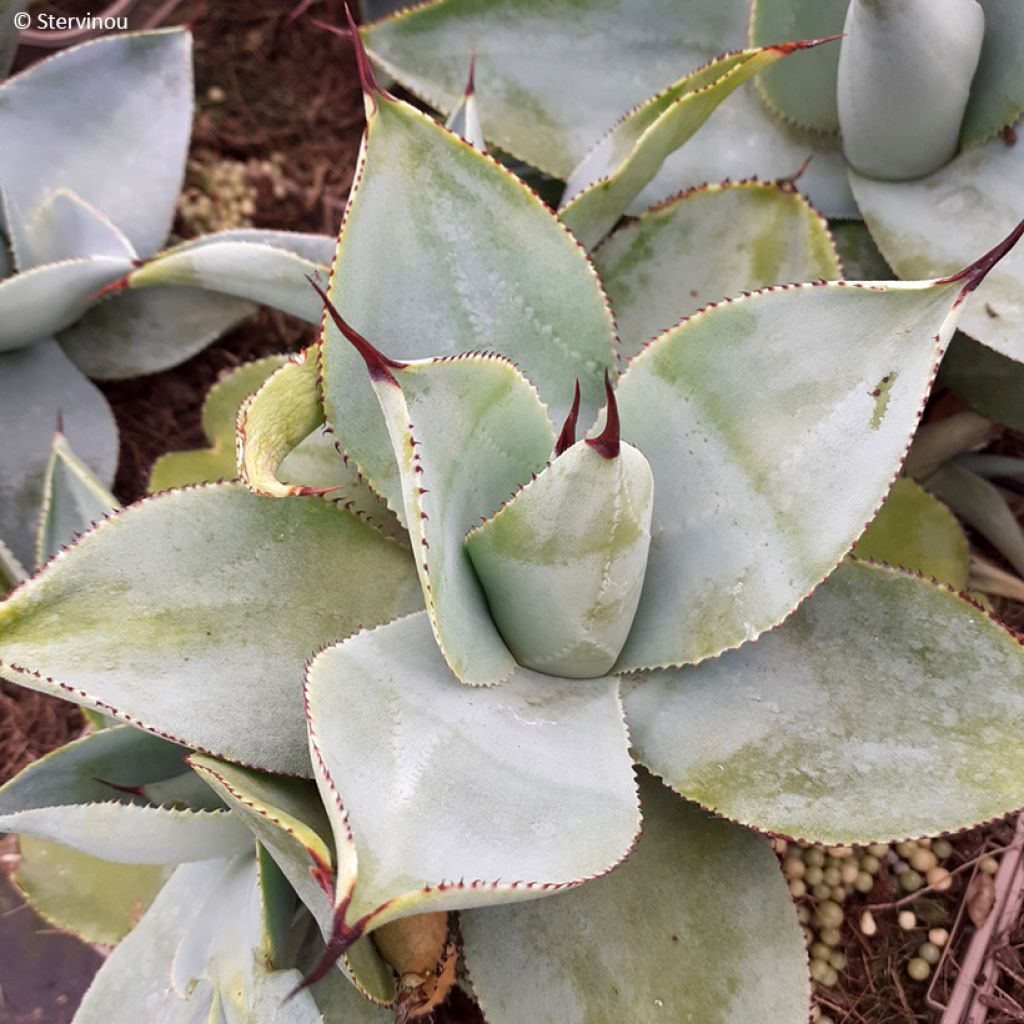

Agave pygmae Dragon Toes
Agave pygmae Dragon Toes
Agave pygmae Dragon Toes
This item cannot be shipped to the selected country
Delivery charge from €5.90
More information
Schedule delivery date,
and select date in basket
This plant carries a 12 months recovery warranty
More information
We guarantee the quality of our plants for a full growing cycle, and will replace at our expense any plant that fails to recover under normal climatic and planting conditions.
From €5.90 for pickup delivery and €6.90 for home delivery
Express home delivery from €8.90.
Does this plant fit my garden?
Set up your Plantfit profile →
Description
The Agave pygmae 'Dragon Toes' is a horticultural species with a compact size and slow growth. It forms a regular rosette composed of wide, imbricate leaves that immediately catch the eye with their superb bluish colour. Their very graphic shape is accentuated by the dark red thorns that spread out around the perimeter to a long, thin terminal spine. This hardy succulent plant will perfectly withstand the summer drought on the French Riviera. Elsewhere, it will be grown in a pot to overwinter away from frost and humidity. Unlike many Agaves, this species tolerates a semi-shaded exposure quite well.
Agave is now classified in the Asparagaceae family, alongside the astonishing Eucomis (pineapple flower) and the charming Peruvian Scilla. The Agave genus is very prolific with around 270 species, some almost dwarf-sized, while others exhibit leaves several meters long. The Agave pygmae is native to the extreme south of Mexico, near the border with Guatemala, where it grows between 900 and 1000 meters above sea level. It is a tropical species, tolerating light frosts (down to -4°C) and in its native habitat, it is exposed to fairly abundant rainfall (1000 mm/year).
'Dragon Toes' is a horticultural selection that captivates with its incredible bluish colour. This slow-growing compact variety eventually forms a rosette 30 to 35 cm in diameter and height, with a perfect geometric shape that enhances its ornamental interest. The succulent leaves are obovate in shape, with a narrow base that widens significantly in the upper third, then narrows sharply to form a sort of wedge, extended by an extremely sharp and prickly rigid spine, approximately 2 cm long. The entire leaf margin is armed with short, sharp spines, dark red in colour, like the terminal spine. The leaves are so compressed vertically against each other before gradually opening to expand the rosette, that they bear, as if printed on their surface, the outlines of neighboring leaves. The patterns of these "Dragon Toes" armed with their claws further enhance the decorative and somewhat fantastical appearance of the plant. The rosette, dense and regular, very open when the plant is in full sun, will be more compact in a subject exposed to semi-shade. As with other species, this Agave eventually flowers after many years of cultivation (10 to 20 years), producing a spike adorned with small yellow-green tubular flowers. The rosette, classified as semelparous, dies after flowering which lasts several months, usually giving off shoots that regenerate a new plant.
Tolerating light frosts, down to -4/-5°C, the Agave pygmae 'Dragon Toes' can reasonably be planted in the open ground only on the coastal strip of the French Riviera, where it will acclimatize very well to the Mediterranean climate. Its small size will allow you to find a place for it even in the smallest gardens, where you can plant it alongside other succulent plants with various shapes, like the Cylindropuntia tunicata. This compact Cactus also forms a dense clump that intrigues with its countless white spines covering it completely. For an aesthetic contrast with these compact silhouettes, you can opt for finesse with the "Red Yucca" (Hesperaloe parviflora 'Rubra') with its long, very fine leaves gathered in a rosette, producing an airy and spectacular summer flowering in salmon pink. In other regions, you will need to overwinter your Agave away from frost and winter humidity, but you can enjoy it on your balcony or terrace for much of the year.
Report an error about the product description
Flowering
Foliage
Plant habit
Botanical data
Agave
pygmae
Dragon Toes
Asparagaceae
Agave potatorum 'Dragon Toes' (erroné)
Cultivar or hybrid
Other Agave
Planting and care
Plant Agave pygmae Dragon Toes in full sun or even possibly in partial shade. Its low hardiness (around -5°C in good conditions) allows planting it in the ground practically only on the French Riviera. In this case, plant it in a preferably poor soil, even rocky, limestone, sandy, but very well-drained. It tolerates winter humidity and cold poorly, but much better dry cold, in a dry soil. Ideally, position it on a mound, slightly inclined, so that rainwater cannot stagnate in the rosette.
As the plant has modest growth, it can be grown in a pot on the terrace or balcony, in a light substrate such as cactus soil, with careful drainage, preferably in terracotta. Water regularly in summer, but let the substrate dry between waterings. It will then be easy to store the pot away from frost and humidity, in a bright, airy, lightly or not heated room. Reduce or even stop watering in winter. The plant can spend the nice season, from April to October, outdoors.
Be sure to wear protective gloves when handling this plant and be very careful of the thorn tips of the leaves, which can be harmful to the eyes!
Planting period
Intended location
Care
This item has not been reviewed yet - be the first to leave a review about it.
Mediterranean perennials
Haven't found what you were looking for?
Hardiness is the lowest winter temperature a plant can endure without suffering serious damage or even dying. However, hardiness is affected by location (a sheltered area, such as a patio), protection (winter cover) and soil type (hardiness is improved by well-drained soil).

Photo Sharing Terms & Conditions
In order to encourage gardeners to interact and share their experiences, Promesse de fleurs offers various media enabling content to be uploaded onto its Site - in particular via the ‘Photo sharing’ module.
The User agrees to refrain from:
- Posting any content that is illegal, prejudicial, insulting, racist, inciteful to hatred, revisionist, contrary to public decency, that infringes on privacy or on the privacy rights of third parties, in particular the publicity rights of persons and goods, intellectual property rights, or the right to privacy.
- Submitting content on behalf of a third party;
- Impersonate the identity of a third party and/or publish any personal information about a third party;
In general, the User undertakes to refrain from any unethical behaviour.
All Content (in particular text, comments, files, images, photos, videos, creative works, etc.), which may be subject to property or intellectual property rights, image or other private rights, shall remain the property of the User, subject to the limited rights granted by the terms of the licence granted by Promesse de fleurs as stated below. Users are at liberty to publish or not to publish such Content on the Site, notably via the ‘Photo Sharing’ facility, and accept that this Content shall be made public and freely accessible, notably on the Internet.
Users further acknowledge, undertake to have ,and guarantee that they hold all necessary rights and permissions to publish such material on the Site, in particular with regard to the legislation in force pertaining to any privacy, property, intellectual property, image, or contractual rights, or rights of any other nature. By publishing such Content on the Site, Users acknowledge accepting full liability as publishers of the Content within the meaning of the law, and grant Promesse de fleurs, free of charge, an inclusive, worldwide licence for the said Content for the entire duration of its publication, including all reproduction, representation, up/downloading, displaying, performing, transmission, and storage rights.
Users also grant permission for their name to be linked to the Content and accept that this link may not always be made available.
By engaging in posting material, Users consent to their Content becoming automatically accessible on the Internet, in particular on other sites and/or blogs and/or web pages of the Promesse de fleurs site, including in particular social pages and the Promesse de fleurs catalogue.
Users may secure the removal of entrusted content free of charge by issuing a simple request via our contact form.
The flowering period indicated on our website applies to countries and regions located in USDA zone 8 (France, the United Kingdom, Ireland, the Netherlands, etc.)
It will vary according to where you live:
- In zones 9 to 10 (Italy, Spain, Greece, etc.), flowering will occur about 2 to 4 weeks earlier.
- In zones 6 to 7 (Germany, Poland, Slovenia, and lower mountainous regions), flowering will be delayed by 2 to 3 weeks.
- In zone 5 (Central Europe, Scandinavia), blooming will be delayed by 3 to 5 weeks.
In temperate climates, pruning of spring-flowering shrubs (forsythia, spireas, etc.) should be done just after flowering.
Pruning of summer-flowering shrubs (Indian Lilac, Perovskia, etc.) can be done in winter or spring.
In cold regions as well as with frost-sensitive plants, avoid pruning too early when severe frosts may still occur.
The planting period indicated on our website applies to countries and regions located in USDA zone 8 (France, United Kingdom, Ireland, Netherlands).
It will vary according to where you live:
- In Mediterranean zones (Marseille, Madrid, Milan, etc.), autumn and winter are the best planting periods.
- In continental zones (Strasbourg, Munich, Vienna, etc.), delay planting by 2 to 3 weeks in spring and bring it forward by 2 to 4 weeks in autumn.
- In mountainous regions (the Alps, Pyrenees, Carpathians, etc.), it is best to plant in late spring (May-June) or late summer (August-September).
The harvesting period indicated on our website applies to countries and regions in USDA zone 8 (France, England, Ireland, the Netherlands).
In colder areas (Scandinavia, Poland, Austria...) fruit and vegetable harvests are likely to be delayed by 3-4 weeks.
In warmer areas (Italy, Spain, Greece, etc.), harvesting will probably take place earlier, depending on weather conditions.
The sowing periods indicated on our website apply to countries and regions within USDA Zone 8 (France, UK, Ireland, Netherlands).
In colder areas (Scandinavia, Poland, Austria...), delay any outdoor sowing by 3-4 weeks, or sow under glass.
In warmer climes (Italy, Spain, Greece, etc.), bring outdoor sowing forward by a few weeks.

































